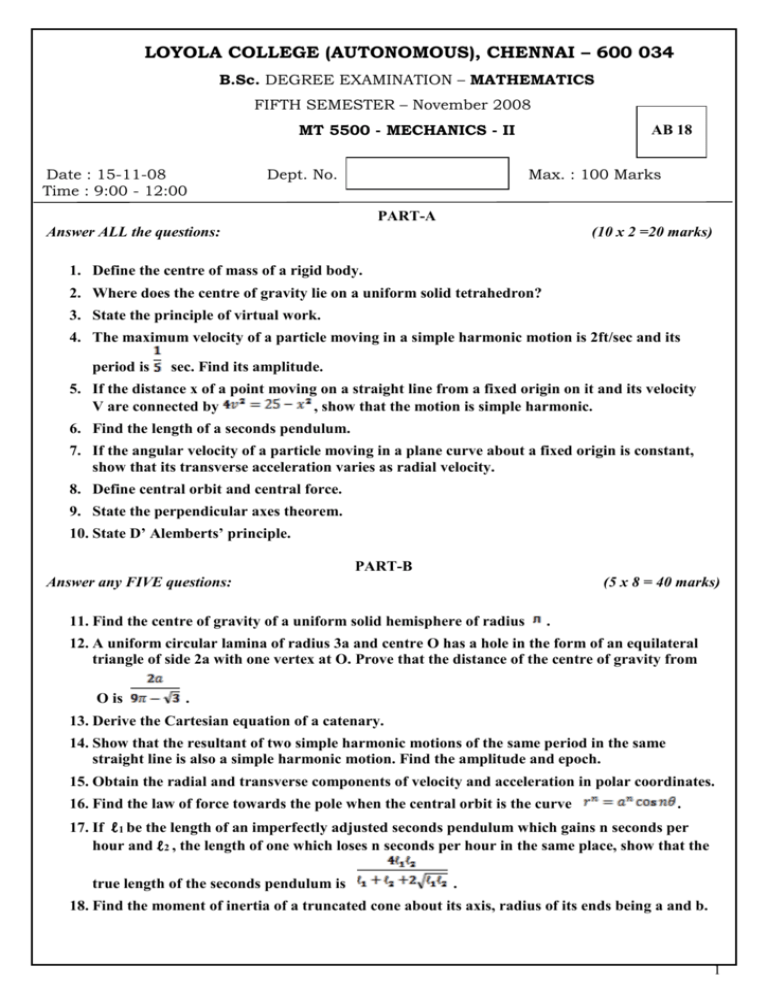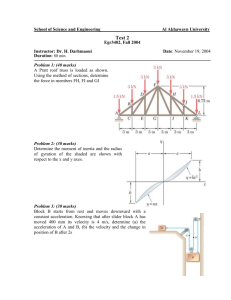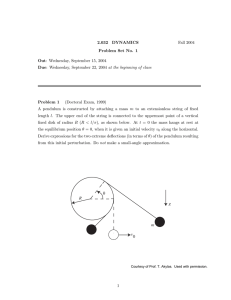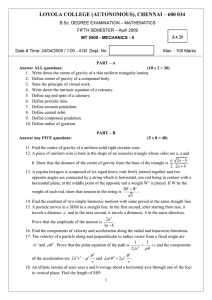mt 5500 - mechanics - ii
advertisement

LOYOLA COLLEGE (AUTONOMOUS), CHENNAI – 600 034 B.Sc. DEGREE EXAMINATION – MATHEMATICS FIFTH SEMESTER – November 2008 MT 5500 - MECHANICS - II Date : 15-11-08 Time : 9:00 - 12:00 Dept. No. AB 18 Max. : 100 Marks PART-A Answer ALL the questions: (10 x 2 =20 marks) 1. Define the centre of mass of a rigid body. 2. Where does the centre of gravity lie on a uniform solid tetrahedron? 3. State the principle of virtual work. 4. The maximum velocity of a particle moving in a simple harmonic motion is 2ft/sec and its period is sec. Find its amplitude. 5. If the distance x of a point moving on a straight line from a fixed origin on it and its velocity V are connected by , show that the motion is simple harmonic. 6. Find the length of a seconds pendulum. 7. If the angular velocity of a particle moving in a plane curve about a fixed origin is constant, show that its transverse acceleration varies as radial velocity. 8. Define central orbit and central force. 9. State the perpendicular axes theorem. 10. State D’ Alemberts’ principle. PART-B Answer any FIVE questions: (5 x 8 = 40 marks) 11. Find the centre of gravity of a uniform solid hemisphere of radius . 12. A uniform circular lamina of radius 3a and centre O has a hole in the form of an equilateral triangle of side 2a with one vertex at O. Prove that the distance of the centre of gravity from O is . 13. Derive the Cartesian equation of a catenary. 14. Show that the resultant of two simple harmonic motions of the same period in the same straight line is also a simple harmonic motion. Find the amplitude and epoch. 15. Obtain the radial and transverse components of velocity and acceleration in polar coordinates. 16. Find the law of force towards the pole when the central orbit is the curve . 17. If ℓ1 be the length of an imperfectly adjusted seconds pendulum which gains n seconds per hour and ℓ2 , the length of one which loses n seconds per hour in the same place, show that the true length of the seconds pendulum is . 18. Find the moment of inertia of a truncated cone about its axis, radius of its ends being a and b. 1 PART-C Answer any TWO questions: (2 x 20 = 40 marks) 19. a) Four equal rods, each of length a, are joined to form a rhombus ABCD and the points B and D are joined by a string of length ℓ. The system is placed in a vertical plane with A resting on a horizontal plane and AC vertical. Prove that the tension in the string is where is the weight of the rod. b) Find the centre of gravity of the area enclosed by the parabolas . 20. a) A point moves with uniform speed v along the cardioids i) its angular velocity and (10+10) Show that about pole is ii) radial component of acceleration is constant, iii) magnitude of resultant is . b) Derive the pedal equation of the central orbit. (10+10) 21. a) State and prove the parallel axes theorem concerning moment of inertia. b) A solid sphere is rolling down a plane, inclined to the horizon at an angle α and rough enough to prevent any sliding. Find its acceleration. (10+10) 22. a) A particle is performing simple harmonic motion of period T about a centre O and it passes through the position P (where op = b) with velocity v in the direction op. Prove that the time that elapses before it returns to P is . b) Two particles of masses M and M1 respectively are attached to the lower end of an elastic string whose upper end is fixed and are hung at rest. M1 falls off. Show that the distance of M from the upper end of the string at time t is where a is the unstretched length of the string; b and c are the distance by which it would be stretched when supporting M and M1, respectively. (10+10) *************** 2







